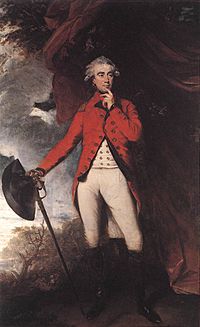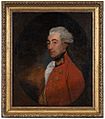Francis Rawdon-Hastings, 1st Marquess of Hastings facts for kids
Quick facts for kids
The Most Honourable
The Marquess of Hastings
|
|
|---|---|

The Marquess of Hastings as Governor-General of India by Joshua Reynolds
|
|
| Governor-General of India | |
| In office 4 October 1813 – 9 January 1823 |
|
| Monarch | George III George IV |
| Preceded by | The Lord Minto |
| Succeeded by | John Adam As Acting Governor-General |
| Governor of Malta | |
| In office 22 March 1824 – 28 November 1826 |
|
| Monarch | George IV |
| Preceded by | Hon. Thomas Maitland |
| Succeeded by | Alexander George Woodford As Acting Governor |
| Personal details | |
| Born | 9 December 1754 County Down, Kingdom of Ireland |
| Died | 28 November 1826 (aged 71) At sea off Naples |
| Nationality | British |
| Spouses | Flora Campbell, 6th Countess of Loudoun (1780–1840) |
| Military service | |
| Allegiance | |
| Branch/service | British Army |
| Rank | General |
| Commands | Commander-in-Chief of India |
| Battles/wars | American War of Independence War of the First Coalition Anglo-Nepalese War Third Anglo-Maratha War |
Francis Edward Rawdon-Hastings, 1st Marquess of Hastings (born December 9, 1754 – died November 28, 1826) was an important Anglo-Irish politician and army officer. He is best known for serving as the Governor-General of India from 1813 to 1823. Before that, he fought with British forces in the American Revolutionary War and in the War of the First Coalition against France. He added "Hastings" to his name in 1790, following his uncle's wishes.
Contents
Military Adventures
Francis Rawdon-Hastings joined the British Army on August 7, 1771. He started as an ensign, which was a junior officer rank. He briefly attended Oxford University but left to join his regiment. In 1773, he was promoted to lieutenant and sailed to America in 1774.
Fighting in the American Revolutionary War
Rawdon was in Boston when the Battles of Lexington and Concord happened. He first saw real action at the Battle of Bunker Hill. He bravely led his company during a successful attack, even taking command when his captain was wounded. His bravery was noticed, and he was promoted to Captain.
During the winter of 1774-1775 in Boston, he even performed in a play! He then became an aide to General Henry Clinton. He joined Clinton on expeditions to North Carolina and South Carolina, including the attack on Fort Moultrie.
Key Battles in America
In September 1776, Rawdon led his men during a landing on Manhattan island at Kip's Bay. The next day, he helped his troops in a fight at Battle of Harlem Heights. He also took part in the landings at Pell's Point and the battle at Battle of White Plains.
In 1777, he returned to America and helped capture Fort Constitution in the New York Highlands. Later, he formed a new regiment called the Volunteers of Ireland, made up of Irish soldiers. He was promoted to colonel and fought in the withdrawal from Philadelphia to New York, including the Monmouth Court House.
The Southern Campaign
Rawdon went south to help with the Siege of Charleston. He was then put in charge of British forces in South Carolina by Lord Cornwallis. His most famous victory was at the Battle of Hobkirk's Hill. There, with a smaller force, he used his skill to defeat a much larger American army.
However, he eventually had to retreat towards Charleston due to his health. In July 1781, he left his command. He was captured at sea but was later exchanged.
Campaigns in Europe
After France declared war on Great Britain, Rawdon-Hastings was made a major general in 1793. In 1794, he led an expedition to Ostend, France, to join the Duke of York's army. However, the French army, led by General Pichegru, forced the British to retreat. Rawdon-Hastings left the expedition after this.
A Life in Politics
In 1783, Francis Rawdon-Hastings became the Baron of Rawdon. He also became friends with the Prince of Wales, who later became King George IV. He loaned the Prince a lot of money. In 1789, he officially added "Hastings" to his name.
When his father died in 1793, he became the 2nd Earl of Moira. He served in the House of Lords, which is part of the British Parliament, for 30 years.
He joined the Whig political party. In 1806, he became the Master-General of the Ordnance in the government. However, he resigned the next year when the government changed. Because he was close to the Prince-Regent, he was asked to try and form a new government in 1812, but his attempts were not successful.
Leading India
Through the Prince-Regent's influence, Rawdon-Hastings was appointed Governor-General of India on November 11, 1812. His time in India was very important. He oversaw victories in the Gurkha War (1814–1816) and the final defeat of the Maratha people in 1818. He also helped purchase the island of Singapore in 1819.
He arrived in India in September 1813 and settled in Calcutta. At that time, British India included Madras, Bengal, and Bombay. He commanded a large army of British and Indian soldiers.
The Gurkha War
In May 1813, the Gurkhas declared war. Hastings sent four different armies to attack. Only General David Ochterlony had success at first. After some talks that didn't work out, Hastings sent more soldiers to Ochterlony, who then won the battle of Makwanpur. This led to a peace treaty called the Sugauli Treaty.
The Maratha Wars
In 1817, Hastings led forces against the Pindaris and the Marathas. The Maratha leader, the Peshwa, was defeated. Other Maratha leaders were also defeated in battles like Nagpur and Battle of Mahidpur. This led to the final conquest of the Marathas.
Making a Difference in India
Rawdon-Hastings was also good at diplomacy, which means managing relationships with other countries or states. He protected weaker Indian states. His policies within India were also successful. He helped repair the old Mughul canal system in Delhi in 1820. He also made improvements in education and how the government was run. Because of his achievements, he was given the title of Marquess of Hastings in 1817.
He confirmed the purchase of Singapore from the Sultan of Jahore by Sir Stamford Raffles in January 1819.
His time in India ended in 1823 due to a financial issue, and he returned to England. He was then appointed Governor-General of Malta in 1824. He died at sea near Naples two years later.
His Family
On July 12, 1804, he married Flora Campbell, 6th Countess of Loudoun. They had six children together:
- Hon. Francis George Augustus (1807-1807), who died as a baby.
- Flora Elizabeth Rawdon-Hastings (February 11, 1806 – July 5, 1839), who never married.
- George Augustus Francis Rawdon-Hastings, 2nd Marquess of Hastings (February 4, 1808 – January 13, 1844).
- Sophia Frederica Christina Rawdon-Hastings (February 1, 1809 – December 28, 1859), who married John Crichton-Stuart, 2nd Marquess of Bute.
- Selina Constance Rawdon-Hastings (1810 – November 8, 1867), who married Charles Henry.
- Adelaide Augusta Lavinia Rawdon-Hastings (February 25, 1812 – December 6, 1860), who married William Murray, 7th Baronet of Octertyre.
The Marquess also had another son, George Hunn Nobbs, with Jemima French.
Images for kids
-
Trumbull's The Death of General Warren at the Battle of Bunker Hill. Lieutenant Rawdon can be seen prominently in the background standing on the American breastworks waving the British Ensign
-
The Marquess of Hastings as Governor-General of India by Joshua Reynolds
-
The Marquess of Hastings as Governor-General of India
-
Marquess of Hastings by Hugh Douglas Hamilton (c. 1801)
-
Marquess of Hastings, Governor-General of India by Joshua Reynolds (c. 1812)
-
Francis Rawdon, Marquess of Hastings by Henry Raeburn. 1813
-
portrait by Gilbert Stuart, c. 1796
See also
 In Spanish: Francis Rawdon-Hastings para niños
In Spanish: Francis Rawdon-Hastings para niños











